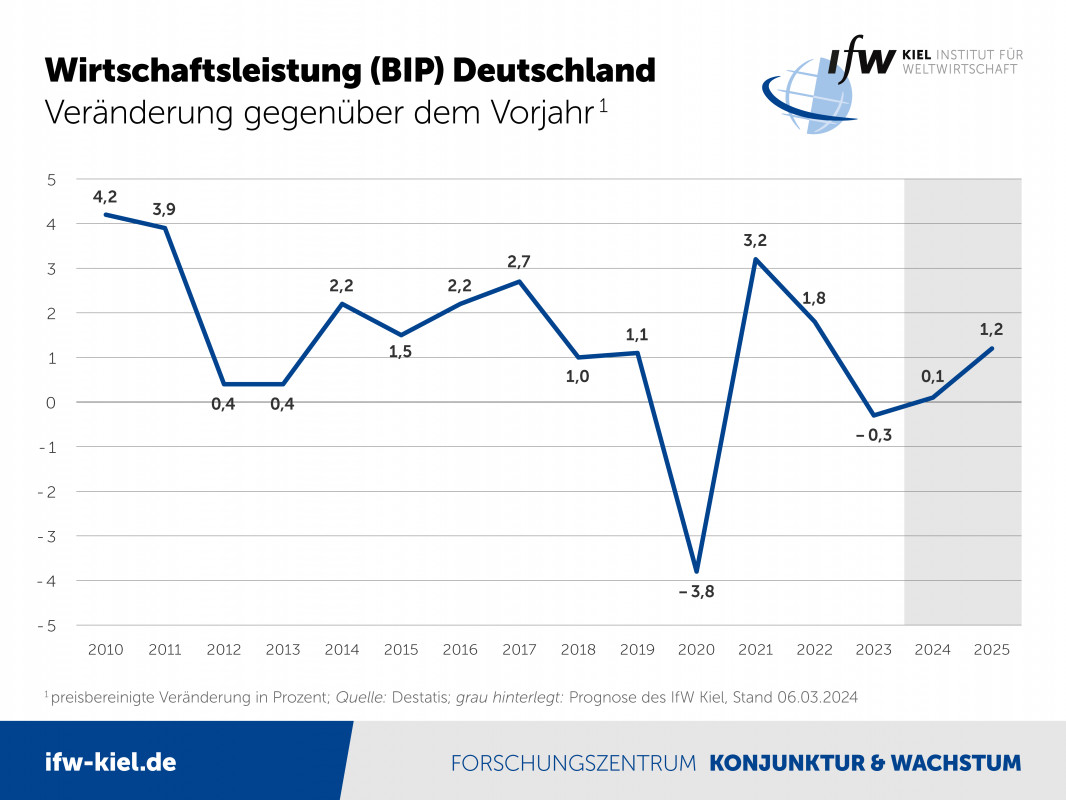
The Kiel Institute is leaving its forecast for 2025 unchanged and expects economic output to grow by 1.2%. The inflation rate is likely to fall to below 2 percent and the government's financing deficit to below 0.8 percent.
"A whole range of factors are currently weighing on sentiment and economic data in the German economy. Exports are suffering from a weakening global economy, the European Central Bank's monetary policy is restrictive and is likely to remain so into the coming year, and the German government's austerity measures have come at an unfavorable time and are exuding additional pessimism," said Moritz Schularick, President of the Kiel Institute, on the occasion of the economic forecasts published today.
German economy in spring 2024: recovery with obstacles
Global economy in spring 2024: momentum remains subdued
After a significant decline in economic output in the final quarter of 2023, the Kiel Institute's forecast also predicts a minimal downturn in the first quarter. A moderate recovery is not expected to set in until spring. However, economic output in 2025 will only be 2% above the level reached before the outbreak of the coronavirus pandemic six years ago.
"Although the German economy will regain momentum over the course of the year, there are no major leaps in sight. There are increasing signs that structural problems in particular are weighing on the economy. Private investment remains the weak point, partly because economic policy is creating a great deal of uncertainty," says Stefan Kooths, Head of Economic Research at the Kiel Institute.
In addition, the Kiel Institute now estimates that corporate investment activity is significantly weaker. Investments in equipment are likely to fall by 1.3 percent in the current year. Construction investment remains under pressure, with residential construction shrinking even more than in the previous two years at 4 percent. From next year, however, small growth rates of around 1% are possible again in the areas mentioned.
Positive signals: declining inflation rate, robust labor market
The upswing is largely being driven by a gradual upturn in private consumption and a gradual increase in foreign business. However, the respective driving forces - rising mass purchasing power in Germany thanks to high wage settlements with a falling inflation rate and rising foreign demand - are weaker or are starting later than previously expected.
The inflation rate is declining: after 8.2% in the first quarter of 2023, it has already fallen to 2.9% and 2.5% in January and February respectively. For the current year, the Kiel Institute is forecasting an inflation rate of 2.3%, with a further decline to 1.7% expected for 2025.
After three consecutive years of decline, real disposable income will increase again by around 1% in 2024 and 2025.
The labor market is robust in view of the weak economic momentum, with the unemployment rate expected to be 5.8% (2024) and 5.6% (2025). The number of people in employment will reach a record 46.1 million in the current year, before turning into a downward trend as a result of demographic change.
The government's financing deficit is declining, mainly due to consolidation measures, and is expected to fall from 2.1% in relation to gross domestic product in 2023 to 0.8% in 2025.
After five quarters in reverse gear, exports are gradually picking up again from the spring. However, due to the weak winter half-year, exports are likely to fall significantly by another 1.7% on average this year, with growth of 2.8% expected for 2025.
The less dynamic but generally stable global economy will once again be driven somewhat more by industrial production. As a result, global trade will overcome its weak phase and support German industry with more orders.
The disruption to shipping traffic in the Red Sea, on the other hand, is likely to have only briefly affected German foreign trade (read more: Cargo volumes in the Red Sea continue to decline, fewer ships in Hamburg).
US presidential election risk
According to the forecast, global production will only increase moderately by 2.8% (2024) and 3.1% (2025). Not least China's structural problems are preventing stronger growth. The economy there is likely to grow at rates of just under 5% this year and next. India is the driving force with growth rates of just under 7%.
The US economy is the strongest in the developed economies. In 2024, economic output is likely to grow strongly by more than 2%, with momentum slowing somewhat in 2025 as a result of the fiscal stimulus from the election year.
"The presidential election in the USA is a major source of uncertainty for the global economy and the prospects for the German economy. If Donald Trump wins the race, new trade conflicts as a result of protectionist initiatives threaten to impair the recovery of global trade. These risks are offset by only very limited opportunities for trade facilitation - for example through new free trade agreements," says Kooths.


